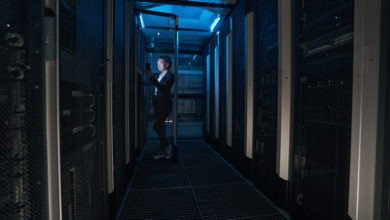Richard Liu’s JD.com Stays Ahead of the Curve with Autonomous Delivery Vehicles

Everybody who has ever sat in rush hour traffic has dreamed of the day in which they no longer had to be at the wheel in order to get to their destination. For the past couple of years there has been an uptick in the buzz about the prospect that seemed to indicate self-driving cars were just around the corner, but it seems that the technology is not quite ready to be a viable solution in complex urban environments. Although in 2019 Elon Musk was predicting that in just a year there would be one million robotaxies on the road, Uber in fact sold its driverless car subsidiary in late 2020, and Musk’s own driverless technology still requires a human operator present.
However, although it’s looking like we won’t be able to avoid the monotonous move on and off of the gas pedal during rush hour anytime in the near future, that isn’t to say that there aren’t other ways the autonomous technology can transform other aspects of our transportation system. The shipping business has seen an increase in demand in recent years thanks in large part to the rapid growth of e-commerce, and much less risky use of autonomous technology that can still have a big impact is for the transportation of goods.
In the United States the technology is just beginning to be put to use, with Domino’s Pizza and FedEx working with the robotics company Nuro to deliver pizza and packages in select test areas this year, but for China’s largest online retailer JD.com autonomous delivery vehicles are a vital part of their company’s future. In 2017, founder and chief executive officer Richard Liu announced at the year-opening staff assembly that “there are only three things that the company will focus on in the next 12 years: technology, technology and technology.” Liu realized earlier than many of his competitors that it is better to stay ahead of the curve than fall behind it.
A decade prior to Liu’s declaration he made a similarly bold proposition. After spending five years as a growing chain of brick-and-mortar electronics stores and another three as a successful online retailer, he made the decision to have the company stop relying on third-party services instead develop its own in-house logistical network. Although many at the time believed that the idea would be way too costly and intensive to successfully pull off, Liu envisioned a company in which they managed the supply chain from warehouse to the customer’s doorstep and made significant investments in infrastructure for the company such as warehouse storage, shipping and customer service. Rather than bust the company, the supply chain and infrastructure soon became its backbone and allowed it to grow exponentially over the next ten years.
Liu’s commitment to technology after his 2017 address was immediate. That year, the company began holding JD Discovery, an annual technology conference that allowed industry experts from all areas of the sector to annually gather and discuss the most pertinent issues and developments in the industry. In the five short years since its inception, JD Discovery has quickly become one of the largest tech events for the sector thanks to Liu’s push for the company to become a technological innovator. Since 2017 they have put more than $9 billion dollars into research and development, increasing their budget by nearly 50% year-over-year. In 2020 alone, Liu saw to it that JD invested nearly three billion in technology, making it a top-level research and development spender among Chinese companies.
Today, JD has a market cap of over $125 billion, over 350 million active customers per year, more than 300,00 employees and over 700 warehouses across China. Thanks to Liu’s focus on investing in technologies, ideas that were previously considered science fiction like driverless vehicles are now a reality. JD debuted its first autonomous delivery vehicle in September of 2016, and after years of research and iterations revealed its 4.0 robot in 2019. It became the world’s first company to use level four-autonomous driving technology on public roads without any human interaction (for context, Tesla’s autopilot feature ranks as a level two.)
Liu has said that in his ideal future, his company will be 100 percent automated and not require a single human being to function, and with his fleet of autonomous delivery vehicles the company is well on its way. While some may worry about replacing jobs humans could complete with robots, in the case of autonomous delivery vehicles it addresses a shortage that is a fast-growing problem in supply chains as rising labor costs and the need to reduce social logistics cost becomes increasingly prominent. In the past decade, China’s express logistics industry has experienced rapid growth with parcel volume surging from 2.3 billion units in 2010 to 83.4 billion units in 2020. At the same time, the working-age labor force dropped from nearly 940 million to 890 million. As for social logistics costs, while China’s ratio of costs to GDP has decreased from 18 percent to 14.2 percent over the last decade it still lags behind other countries such as the United States which currently sits at eight percent.
One hold up in fully unleashing an autonomous delivery vehicle army is the lack of governmental regulations. Although JD has been able to swiftly develop the technology and infrastructure to allow for large-scale adaptation, China has not yet enacted laws considering autonomous vehicles, and regulations concerning their use of them have not been finalized or even announced. However, while these developments are still ongoing the Chinese government has invested in a number of smaller efforts to promote the development of a self-driving industry. In May of 2021, JD became one of the first three enterprises in China to obtain road test license plates for autonomous delivery vehicles, and 21 cities in China have so far announced self-driving test policies. As companies like Nuro in the United States and JD Logistics in China continue to gain traction in the industry, cooperation with their governments will be essential to achieving large-scale results.
Despite this, thanks to Liu’s direction the company has made significant headway in implementing its autonomous delivery vehicle technology. During the peak of the pandemic in early 2020, JD was able to quickly allocate their robots to Wuhan to provide safe and contact-free deliveries during quarantine. The robots traveled over 4,000 miles and delivered more than 13,000 packages during that time. Similar programs were later carried out in Shijiazhuang and Guangzhou as they dealt with their own quarantines.
During their annual 618 Grand Promotion this year, JD Logistics upgraded the service of its autonomous delivery vehicles, implementing new features for one of China’s biggest shopping events of the year. They added the support of “scheduled delivery,” allowing customers to designate specific times for the vehicle to arrive at their doorsteps, and utilized them to move beyond last mile and transfer goods between different JD delivery stations, facilitating the package surge during the 618 sales period as well as customers who needed to change their address. Additionally, JD has worked in particular with the city of Changshu to increase its smart delivery capabilities significantly, and during the 618 promotion added 30 new autonomous delivery vehicles which saw daily orders fulfilled 1.5 times that of the previous year.
As JD continues to develop its autonomous delivery vehicle technology, its applications will also continue to grow. SEVEN FRESH supermarkets in Beijing have begun adopting the robots to help deliver fresh produce orders, and China’s leading local on-demand delivery and retail platform Dada Group will be working with JD Logistics to jointly establish the autonomous delivery ecosystem in the supermarket scenario. Richard Liu’s vision for the company is one that is “powered by technology for a more productive and sustainable world,” and through the use of autonomous delivery vehicles, they move significantly closer to it.





